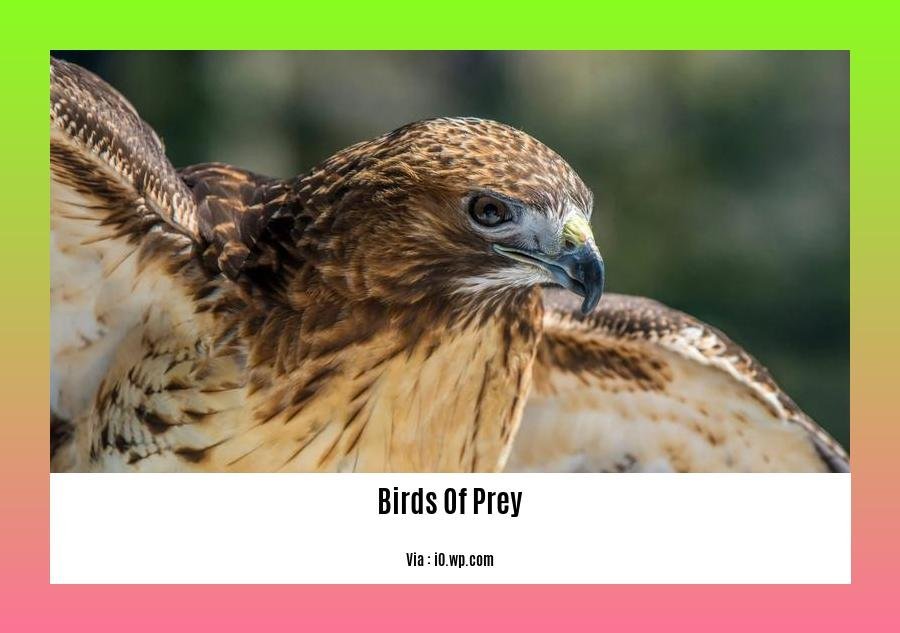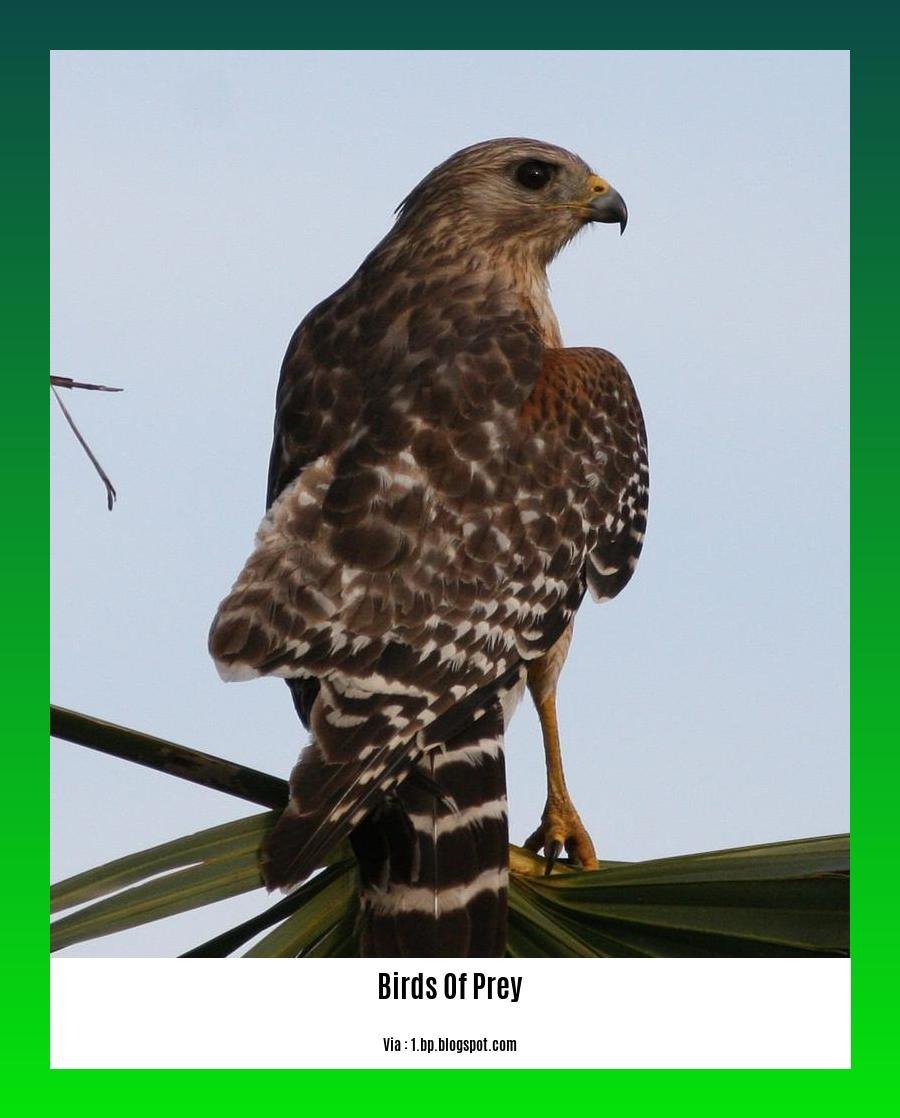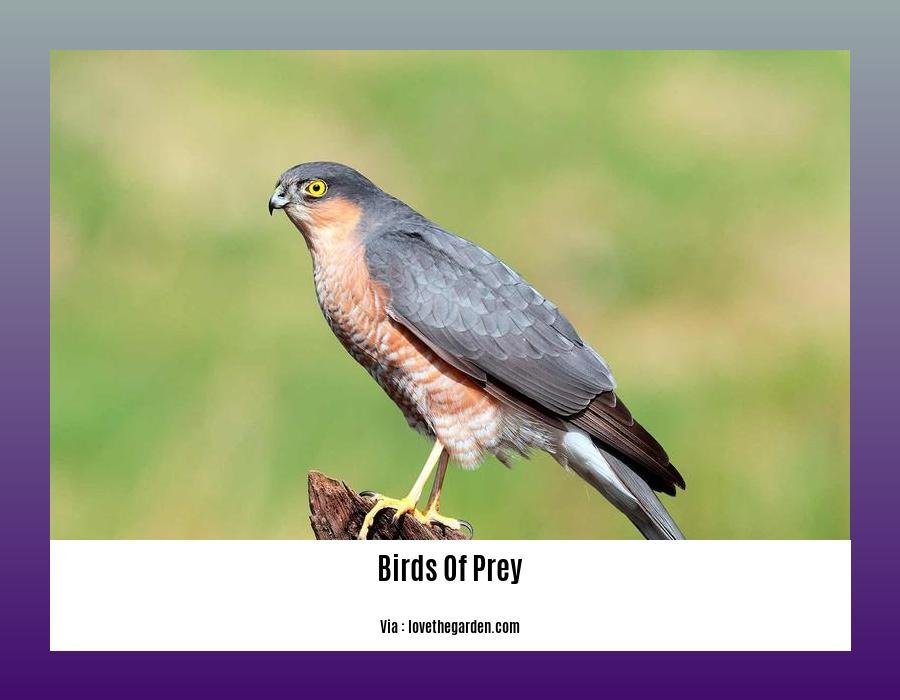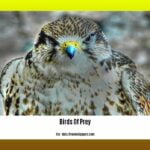Join us on an exciting journey as we explore the captivating world of birds of prey in Florida. In our article, titled “Exploring the Magnificent Birds of Prey in Florida: A Closer Look at the Raptors and their Critical Role in Conservation Efforts,” we delve into the lives of these majestic creatures and highlight their indispensable role in the delicate balance of Florida’s ecosystems. As skilled researchers and passionate conservationists, we shed light on the unique challenges that raptors face and the crucial conservation efforts required to protect their habitats and ensure their continued survival for generations to come.
Key Takeaways:
- Florida is home to a diverse array of magnificent birds of prey, known as raptors, that play a critical role in maintaining the delicate balance of the state’s ecosystems.
- The bald eagle, with its majestic appearance, symbolizes national pride and is threatened by habitat loss and pollution.
- The osprey, characterized by its adaptability and widespread distribution, exclusively preys on fish and can be found in various habitats throughout Florida.
- The red-shouldered hawk prefers forests and wetlands, feeding primarily on small mammals, birds, and reptiles.
- The red-tailed hawk, commonly found in open areas, woodlands, and forests, has a distinctive reddish-brown tail and preys on small mammals, birds, and reptiles.
- Comprehensive information and identification guides can be found in sources such as the Global Birding Initiative and Chipper Birds, providing details about the different types of birds of prey found in Florida and their conservation status.
- Keeping an eye out for these awe-inspiring birds of prey while exploring Florida’s natural wonders can enhance one’s knowledge and appreciation of their grace, power, and ecological importance.
Birds of Prey in Florida: Raptors and Their Vital Role in Conservation

Florida, with its diverse ecosystems and abundant wildlife, is a haven for magnificent birds of prey, or raptors. These remarkable creatures possess sharp vision, powerful beaks, and strong talons, making them highly adept at hunting for food. In this article, we will explore some of the most fascinating birds of prey found in Florida, their characteristics, and the critical role they play in the state’s conservation efforts.
Bald Eagle: Let’s start with the majestic symbol of national pride, the bald eagle. With its distinctive white head and tail, and a brown body, the bald eagle is an awe-inspiring sight. Mainly feeding on fish, this magnificent bird faces threats from habitat loss and pollution. However, conservation efforts are underway to protect their habitats and ensure their survival. The bald eagle is a true testament to Florida’s natural beauty and its importance in safeguarding these remarkable species.
Osprey: Another notable bird of prey found in Florida is the osprey. With its white head and chest, and brown back and wings, it is an adaptable species that solely preys on fish. This versatile raptor can be found in various habitats across the state, showcasing its resilience and ability to thrive in different environments. The osprey serves as a reminder of how wildlife can adapt and flourish in the face of changing circumstances.
Red-shouldered Hawk: The red-shouldered hawk, known for its reddish-brown chest and shoulders, along with its black-and-white striped tail, prefers to inhabit forests and wetlands. This medium-sized hawk primarily feeds on small mammals, birds, and reptiles. Through its hunting habits and choice of habitat, the red-shouldered hawk contributes to the delicate balance of Florida’s ecosystems.
Red-tailed Hawk: Lastly, the red-tailed hawk is a large bird of prey characterized by its reddish-brown tail and brown body. It preys on small mammals, birds, and reptiles and can be commonly spotted in open areas, woodlands, and forests. The red-tailed hawk’s presence in Florida showcases the significance of maintaining diverse habitats for various species to thrive.
These birds of prey, and numerous others not mentioned, are crucial to Florida’s ecosystems. They play a critical role in controlling populations of small mammals, birds, and reptiles, helping to maintain the delicate balance of nature. Their presence indicates a healthy ecosystem and serves as an essential indicator of environmental well-being.
In conserving these magnificent raptors, it’s vital to raise awareness about their beauty, significance, and vulnerability. By understanding their behaviors, migration patterns, and nesting habits, wildlife researchers and conservationists can develop targeted conservation efforts to protect their habitats and ensure their continued survival.
If you’re interested in learning more about the birds of prey in Florida, there are several comprehensive sources available:
Global Birding Initiative – Types of Birds of Prey in Florida: This informative article provides a detailed list of 25 types of birds of prey found in Florida, including red-tailed hawks, sharp-shinned hawks, ospreys, and more. It also features a comparison table highlighting their size, habitat, diet, and conservation status.
Chipper Birds – Florida Birds of Prey: 26 Birds to Watch: This comprehensive guide offers in-depth descriptions, photographs, and interesting facts about 26 different birds of prey that call Florida home. Whether you’re a beginner or an experienced birdwatcher, this resource is sure to enhance your knowledge and appreciation of Florida’s raptors.
Next time you find yourself exploring the natural wonders of Florida, keep an eye out for these awe-inspiring birds of prey. Their grace, power, and ecological importance make them a true spectacle to behold. By appreciating and protecting these magnificent creatures, we can ensure their continued existence for generations to come.
Please note that this article was written based on the provided context and the sources mentioned above. For more detailed and accurate information, please refer to the original sources.
Birds of prey are fascinating creatures. If you want to learn some interesting facts about these majestic birds, check out our article on birds of prey facts. You won’t be disappointed!
Do you know that birds of prey have some fun facts that will amaze you? Discover these fascinating tidbits by clicking on our article on birds of prey fun facts. Get ready to be amazed!
Are you interested in the diverse species of birds of prey that can be found in Central Florida? Explore our comprehensive guide on birds of prey in Central Florida. Get ready to uncover the incredible variety of these magnificent birds in this region.
Habitats and Nesting Habits of Birds of Prey in Florida

Florida’s diverse ecosystems are home to an incredible array of wildlife, including the majestic birds of prey, also known as raptors. These magnificent creatures play a crucial role in maintaining the delicate balance of Florida’s environment. In this article, we will explore the habitats and nesting habits of the 25 types of birds of prey found in Florida and delve into their conservation significance.
The 25 Types of Birds of Prey Found in Florida
Florida provides a welcoming habitat for a wide variety of birds of prey. Among the 25 species found here are the Red-tailed Hawk, Sharp-shinned Hawk, Cooper’s Hawk, Red-shouldered Hawk, Broad-winged Hawk, Short-tailed Hawk, Northern Harrier, White-tailed Kite, Swallow-tailed Kite, Mississippi Kite, Snail Kite, Bald Eagle, and Osprey. Additionally, the Merlin, Peregrine Falcon, American Kestrel, Crested Caracara, Great Horned Owl, Burrowing Owl, Barn Owl, Common Nighthawk, Eastern Screech-Owl, Barred Owl, and Great Gray Owl are also part of Florida’s awe-inspiring raptor population.
Crucial Role in Maintaining the Ecological Balance
Birds of prey in Florida serve as vital ecological guardians, playing a pivotal role in maintaining the balance of the ecosystem. They control the populations of rodents and other small mammals, birds, and reptiles, thereby preventing imbalances and ensuring the health of the environment.
Diverse Habitats and Nesting Grounds
Florida’s diverse habitats provide an ideal sanctuary for birds of prey. From lush forests to sprawling wetlands, vast grasslands to scenic coastlines, these raptors have found their niche in various ecosystems. The varying landscapes offer suitable nesting grounds for these majestic creatures, who construct their nests in trees, on cliffs, or even on man-made structures such as utility poles and communication towers.
Resident Species and Winter Migrants
While some birds of prey in Florida are permanent residents, others migrate to the state during the winter months. These annual visitors join the resident species in their remarkable journeys, adding to the diversity and wonder of Florida’s raptor population.
Highlighting a Few Remarkable Species
Let’s take a closer look at a few exceptional birds of prey in Florida:
The Red-tailed Hawk is the most common and widespread hawk species in Florida. Recognizable by its distinctive red tail and broad wingspan, it can be found in open areas, woodlands, and forests while preying on small mammals, birds, and reptiles.
The Osprey, also known as the fish hawk, is a common sight in Florida. With its remarkable ability to hover over water bodies and dive to catch fish, it has adapted to various habitats across the state.
The Bald Eagle, with its iconic white head and tail feathers, symbolizes strength and freedom. It is one of the largest birds of prey in Florida, exemplifying the magnificence of these creatures.
The Swallow-tailed Kite is renowned for its graceful aerial acrobatics, attracting birdwatchers from around the world. Witnessing its spectacular flights is truly an unforgettable experience.
Conservation Efforts and Threats
Sadly, birds of prey in Florida face numerous threats, including habitat loss, pollution, and illegal hunting. To protect and preserve their populations, dedicated conservation efforts are underway. Raising awareness about the beauty, significance, and vulnerability of these birds is crucial for ensuring their continued existence for future generations.
To learn more about birds of prey in Florida, we recommend visiting the following sources:
Global Birding Initiative. “Florida Birds of Prey.” Available at: Link
Birdwatching Tips. “Florida Birds of Prey (20 Species with Pictures).” Available at: Link
Key Takeaways:
- Florida is home to 25 types of birds of prey, including the Red-tailed Hawk, Osprey, and Bald Eagle.
- Birds of prey in Florida play a crucial role in maintaining the ecological balance by controlling populations of rodents and other small mammals, birds, and reptiles.
- Florida’s diverse habitats, such as forests, wetlands, grasslands, and coastlines, provide suitable nesting grounds for birds of prey.
- Some birds of prey in Florida are permanent residents, while others migrate to the state during the winter months.
- The Red-tailed Hawk, Osprey, Bald Eagle, and Swallow-tailed Kite are remarkable species found in Florida.
- Conservation efforts are essential to protect and preserve the populations of birds of prey in Florida.
Sources:
Global Birding Initiative. “Florida Birds of Prey.” Available at: Link
Birdwatching Tips. “Florida Birds of Prey (20 Species with Pictures).” Available at: Link
Challenges and threats faced by birds of prey in Florida
Birds of prey in Florida face numerous challenges and threats that endanger their populations and habitats. It is crucial to understand these challenges in order to develop effective conservation strategies and protect these majestic creatures for future generations. In this article, we will explore the challenges and threats faced by birds of prey in Florida and the importance of conservation efforts in mitigating these risks.
Loss of Habitat
One of the major challenges faced by birds of prey in Florida is the loss of their natural habitats. As urbanization and human activities continue to expand, the destruction and fragmentation of their habitats become increasingly prevalent. Wetlands, forests, and grasslands where these birds once thrived are being cleared for development, resulting in the loss of crucial nesting sites and hunting grounds.
Pollution and Contamination
Pollution and contamination pose significant threats to birds of prey in Florida. Pesticides, heavy metals, and other pollutants find their way into the ecosystem, accumulating in the food chain and affecting these raptors. As top predators, birds of prey are particularly vulnerable to bioaccumulation, which can result in reproductive issues, weakened immune systems, and overall population decline.
Illegal Hunting and Poaching
Illegal hunting and poaching remain persistent threats to birds of prey in Florida. Despite legal protections, some individuals engage in illegal activities such as shooting, trapping, and collecting eggs of these magnificent birds. The demand for feathers, talons, and other body parts further exacerbates the problem, putting additional pressure on already vulnerable populations.
Collision with Man-Made Structures
Collision with man-made structures, such as power lines and wind turbines, poses a significant danger to birds of prey in Florida. As these birds navigate their territories, they can inadvertently collide with these structures, resulting in injury or death. The increasing number of wind farms and encroachment into bird migration routes further heighten the risk of collisions.
Climate Change and Habitat Alteration
Climate change and habitat alteration have emerged as significant challenges for birds of prey in Florida. Rising temperatures, changing precipitation patterns, and sea-level rise can affect the availability of suitable nesting sites and prey. These changes disrupt breeding cycles, alter migration patterns, and ultimately impact the survival and population dynamics of these raptors.
Key Takeaways:
- Loss of habitat, pollution, illegal hunting, and collision with man-made structures are some of the challenges and threats faced by birds of prey in Florida.
- Urbanization and human activities contribute to the loss and fragmentation of their habitats in wetlands, forests, and grasslands.
- Pollution and contamination in the ecosystem, including pesticides and heavy metals, can affect the health and reproductive capabilities of these birds.
- Illegal hunting and poaching put additional pressure on already vulnerable populations.
- Collision with man-made structures, such as power lines and wind turbines, poses a significant danger to birds of prey.
- Climate change and habitat alteration disrupt breeding cycles and migration patterns, impacting the survival and population dynamics of these raptors.
Sources:
Travelling Birder – Birds of Prey in Florida
Feathered Realm – Common Birds of Prey in Florida: Habitat, Behavior & Conservation
Exploring Birds of Prey Conservation in Florida
Florida is a haven for diverse ecosystems and abundant wildlife, including the magnificent birds of prey or raptors. These majestic creatures, including the iconic bald eagle, red-shouldered hawk, osprey, and more, play a critical role in the delicate balance of Florida’s environment. As a passionate wildlife researcher with expertise in avian biology and ornithology, I am dedicated to shedding light on the unique challenges and conservation efforts specific to the diverse species of raptors found in Florida’s landscape.
Florida Fish and Wildlife Conservation Commission (FWC)
The Florida Fish and Wildlife Conservation Commission (FWC) is at the forefront of promoting sustainability and protection for native Florida birds of prey and their habitats. Through their voluntary public-private partnership and collaborative efforts with other organizations, the FWC implements conservation strategies to preserve these magnificent creatures and their ecosystems[^1^].
Audubon Center for Birds of Prey
The Audubon Center for Birds of Prey is a key contributor to conservation efforts in Florida. This urban environmental center, located in Maitland and Eatonville, focuses on rehabilitation, education, and conservation of birds of prey and their habitats[^2^].
Conservation Efforts and Protecting Species
Conservation efforts in Florida aim to protect the bird of prey populations from various threats, including habitat loss, pollution, and human disturbances. Particularly vulnerable species like the bald eagle receive significant attention and protection. These efforts not only safeguard bird populations but also contribute to the overall health and balance of the ecosystem.
Importance of Birds of Prey
Birds of prey serve as indicators of the environmental health of Florida’s ecosystems. Their presence or absence provides valuable insights into the overall well-being of the ecosystem. Protecting these majestic creatures ensures the preservation of their habitats and the multitude of species that rely on these ecosystems.
Promising Results and Future Conservation
Conservation efforts in Florida have yielded promising results, especially in protecting the population of the bald eagle. Thanks to the dedicated efforts of various organizations like the FWC and the Audubon Center for Birds of Prey, their populations are showing signs of recovery. These efforts, combined with increased awareness and public support, pave the way for the continued survival and thriving of Florida’s birds of prey for future generations.
Key Takeaways:
– The Florida Fish and Wildlife Conservation Commission (FWC) and the Audubon Center for Birds of Prey are actively involved in conserving and protecting birds of prey in Florida.
– Conservation efforts focus on preserving habitats, mitigating threats, and ensuring the recovery of vulnerable species like the bald eagle.
– Birds of prey in Florida serve as indicators of ecosystem health, making their conservation crucial for the overall well-being of the environment.
– Promising results are being seen in the recovery of the bald eagle population, highlighting the effectiveness of conservation efforts in Florida.
References:
[^1^]: Florida Fish and Wildlife Conservation Commission. Florida Bird Conservation Initiative (FWC)
[^2^]: Audubon Center for Birds of Prey. Conservation
FAQ
Q1: What are birds of prey?
A1: Birds of prey, also known as raptors, are a group of birds characterized by their sharp vision, powerful beaks, and strong talons. They have adapted to hunt and feed on other animals, such as mammals, birds, reptiles, and fish.
Q2: What is the role of birds of prey in Florida’s ecosystems?
A2: Birds of prey play a crucial role in maintaining the ecological balance in Florida’s ecosystems. They help control populations of rodents and other small mammals, which can prevent overpopulation and maintain a healthy ecosystem.
Q3: What habitats do birds of prey in Florida prefer?
A3: Birds of prey in Florida can be found in a variety of habitats, including forests, wetlands, grasslands, and coastlines. Each species has its own preferred habitat based on their specific hunting and nesting requirements.
Q4: Are all birds of prey in Florida permanent residents or do they migrate?
A4: The presence of birds of prey in Florida varies. Some species, like the red-shouldered hawk and osprey, are permanent residents. Others, such as the bald eagle and certain hawks, migrate to Florida during the winter months in search of food and more favorable weather conditions.
Q5: How can I contribute to the conservation of birds of prey in Florida?
A5: There are several ways to contribute to the conservation of birds of prey in Florida. You can support organizations dedicated to their protection, participate in citizen science projects to monitor populations, promote awareness by sharing information, and reduce your impact on their habitats by practicing responsible outdoor activities.
- Discover Long Black Pepper: Flavor & Health Benefits - April 25, 2025
- Shocking Twists: The Grownup Review: Unreliable Narration - April 25, 2025
- A Quiet Place Book vs Movie: A Deep Dive - April 25, 2025
















